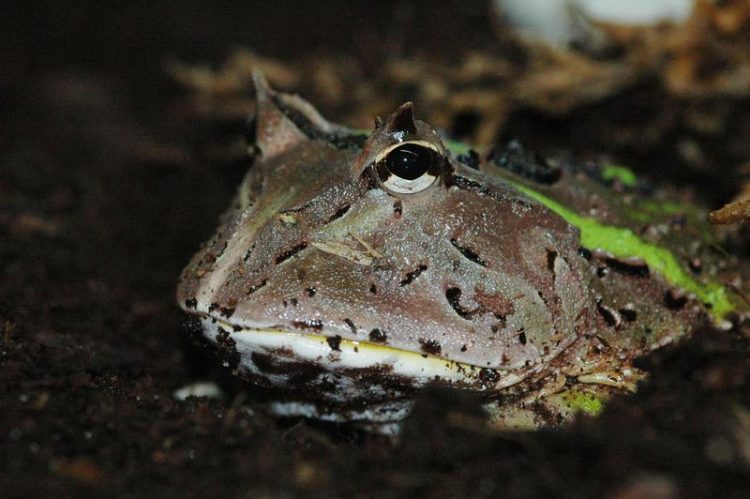How frogs' tongues become sticky

The horned frog lurks for its prey, halfway entrenched. Foto/Copyright: Thomas Kleinteich
Frogs' capture their prey with the sticky mucus covering their tongues, but this mucus isn't inherently adhesive. Frog mucus is thought to be pressure-sensitive, with tongue retraction strain triggering adhesion.
A research team from Oregan State University, Aarhus University and Kiel University has now observed mucus stuck to prey to form fibrils, leading to the hypothesis that glycosylated mucin proteins are reordered by tongue retraction.
Understanding the chemical mechanism of this process can inform design of biomimetic materials, and so the scientists have used new techniques to examine the surface chemistry of frog tongues. They published their results this week in Biointerphases.
“We are able to take a chemical image of the frog tongue print and then look at the outer four to five nanometers of the surface. Our techniques are really surface sensitive, and that's where we think most of the action takes place,” said co-author Joe E. Baio, whose group was involved in developing the near-edge x-ray absorption fine structure (NEXAFS) microscopy techniques used in this study.
NEXAFS and sum frequency generation of vibrational spectra enabled analysis of the interfacial chemistry of 'mucus prints'. These prints were gathered by the Group of Professor Stanislav Gorb from Kiel University, who also inspired the study. They tempted horned frogs into launching their tongues at crickets cunningly placed behind glass microscope slides.
„Afterwards we analysed these prints chemically. This way we can explain the physical-chemical processes on frog tongues for the first time and futher contribute to the understanding of the pressure sensitivity of the mucus”, says Gorb.
The group found that the secondary structures of frog tongue mucins are randomly arranged, but upon tongue retraction, molecules align into well-ordered fibrils. With hydrophobic groups orientated towards the slide surface and hydrophilic groups towards the mucus bulk. “The physical input changes the chemistry of the mucus and that's how it turns the glue on,” said Baio.
Next, the team consisting of zoologists, chemists and physicists wants to find the specific mucin sequence in order to replicate the inherent reversibility inartificial pressure-sensitive adhesives.
Photos are available to download:
https://www.uni-kiel.de/fileadmin/user_upload/pressemitteilungen/2018/372-frosch…
Capture: The horned frog lurks for its prey, halfway entrenched.
Foto/Copyright: Thomas Kleinteich
https://www.uni-kiel.de/fileadmin/user_upload/pressemitteilungen/2018/372-frosch…
Capture: The new microscopy techniques show different chemical compositions on the surfaces of frog tongues.
Foto/Copyright: Joe Baio
Contact:
Professor Stanislav N. Gorb
Institute of Zoology of Kiel University
Telephone: 0431/880-4513
sgorb@zoologie.uni-kiel.de
http://www.uni-kiel.de/zoologie/gorb/topics.html
Julia Siekmann
Science Communication Kiel Nano, Surface and Interface Science (KiNSIS)
Tel. 0431-880-4855
jsiekmann@uv.uni-kiel.de
http://www.kinsis.uni-kiel.de
Details, which are only a millionth of a millimetre in size: this is what the priority research area “Kiel Nano, Surface and Interface Science – KiNSIS” at Kiel University has been working on. In the nano-cosmos, different laws prevail than in the macroscopic world – those of quantum physics. Through intensive, interdisciplinary cooperation between physics, chemistry, engineering and life sciences, the priority research area aims to understand the systems in this dimension and to implement the findings in an application-oriented manner. Molecular machines, innovative sensors, bionic materials, quantum computers, advanced therapies and much more could be the result.
Christian-Albrechts-Universität zu Kiel
Presse, Kommunikation und Marketing, Dr. Boris Pawlowski, Text/Redaktion: Louisa Cockbill, AIP, Julia Siekmann, CAU Postanschrift: D-24098 Kiel, Telefon: (0431) 880-2104, Telefax: (0431) 880-1355 E-Mail: presse@uv.uni-kiel.de, Internet: http://www.uni-kiel.de, Twitter: http://www.twitter.com/kieluni, Facebook: http://www.facebook.com/kieluni, Instagram: www.instagram.com/kieluni
Professor Stanislav N. Gorb
Institute of Zoology of Kiel University
Telephone: 0431/880-4513
sgorb@zoologie.uni-kiel.de
www.uni-kiel.de/zoologie/gorb/topics.html
Source: “The Surface Chemistry of the Frog Sticky-Tongue Mechanism,” by J. E. Fowler, Thomas Kleinteich, Johannes Franz, Cherno Jaye, Daniel A. Fischer, Stanislav Gorb, Tobias Weidner and Joe E. Baio, Biointerphases(2018).
https://doi.org/10.1116/1.5052651
https://www.uni-kiel.de/en/details/news/how-frogs-tongues-become-sticky/
Media Contact
All latest news from the category: Life Sciences and Chemistry
Articles and reports from the Life Sciences and chemistry area deal with applied and basic research into modern biology, chemistry and human medicine.
Valuable information can be found on a range of life sciences fields including bacteriology, biochemistry, bionics, bioinformatics, biophysics, biotechnology, genetics, geobotany, human biology, marine biology, microbiology, molecular biology, cellular biology, zoology, bioinorganic chemistry, microchemistry and environmental chemistry.
Newest articles

High-energy-density aqueous battery based on halogen multi-electron transfer
Traditional non-aqueous lithium-ion batteries have a high energy density, but their safety is compromised due to the flammable organic electrolytes they utilize. Aqueous batteries use water as the solvent for…

First-ever combined heart pump and pig kidney transplant
…gives new hope to patient with terminal illness. Surgeons at NYU Langone Health performed the first-ever combined mechanical heart pump and gene-edited pig kidney transplant surgery in a 54-year-old woman…

Biophysics: Testing how well biomarkers work
LMU researchers have developed a method to determine how reliably target proteins can be labeled using super-resolution fluorescence microscopy. Modern microscopy techniques make it possible to examine the inner workings…





















